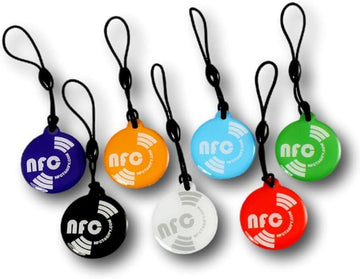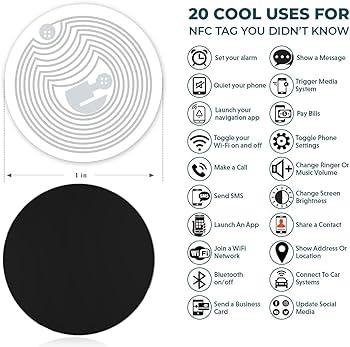QR codes and
NFC tags are technologies that both allow for quick and easy transfer of information between devices. QR codes, or Quick Response codes, are barcodes that can be scanned with a mobile device's camera, and it gives the user access to information stored within the code. These are often used in marketing and advertising, as they can be easily printed on materials such as flyers or billboards. NFC tag, on the other hand, uses near-field communication technology to transfer information. This technology allows devices to communicate with each other by simply bringing them into close proximity to one another. NFC tags can be read by any device with NFC capabilities, such as smartphones and tablets. They can be used for tasks such as making payments, accessing information, or interacting with smart devices. While both QR codes and NFC tags have their own unique features and capabilities, they can also be used in similar ways. Both technologies can be used to transfer information and access content quickly and easily, making them useful tools in a variety of settings.

Difference Between QR Codes and NFC Tags
One of the most significant differences between NFC tags and QR codes is the cost of making them. You can get QR codes for free as there are websites that generate QR codes without having to pay for anything. On the other hand, you need to pay for
custom NFC tags. Most of the time, creating QR codes is free. However, a user would need to pay if they want additional features or customize their QR code. This payment can usually come in the form of monthly subscriptions that costs $10 to $50 a month. On the other hand, an NFC tag usually has a one-time payment of $.02 to $1.
There are two types of QR codes, static and dynamic QR codes. Static
QR codes are QR codes that cannot be rewritten. Once a QR code is created, it cannot be altered or changed. On the other hand, dynamic codes are QR codes that the users can edit but not rewrite. The case is different for NFC tags. NFC tags can be rewritten over and over again. Rewriting the tag just means that the tag's original data is erased, and new data is written in its place. NFC tags can be written over and used again. The only rule is that a user must be within a few inches of the tag, and the tag must not be locked for it to be rewritten.
When scanning QR codes, the user needs to depend on their phone camera to go to the QR code's URL. This feature gives the user easy access to every QR code because almost everyone nowadays has their own smartphone. However, the QR code has to be the right size in order for the camera to detect it. Cameras can also have a hard time detecting QR codes when outside or in direct light. This is why it is not advisable for QR codes to be laminated because it produces glare. On the other hand, phone cameras can't focus as well in the dark. When it comes to NFC tags, the user doesn't need to use their phone camera. But NFC tags do need a specific phone and a software update for them to be used. This problem with compatibility is the biggest drawback from the user's point of view since many people don't have a phone or software that can scan an NFC tag. This is less of a problem now, though, because NFC is becoming more common in smart devices. Additionally, standards are being put in place to help keep NFC data safe.
QR codes are a type of 2D barcode that can be scanned using a smartphone or other device with a camera. They are generally considered less secure than NFC tags because they can be easily copied or forged. They do not have any built-in encryption or authentication features, so there is no way to verify that the information contained in a QR code is genuine. NFC tags, on the other hand, are small, wireless chips that use near-field communication technology to transmit data. They are more secure than QR codes because they can be encrypted and can include authentication features. This makes it much harder for someone to forge or alter the information contained on an NFC tag. In addition, NFC tags require close proximity to a reader device in order to work, which makes them less vulnerable to hacking or tampering. Overall, NFC tags offer a higher level of security compared to QR codes.
What should you choose for your business?
There are several factors you should consider when choosing between NFC tags and QR codes. The audience segment is one of these factors. The best for your business depends on whether Android phones and iPhones are dominant in your area. Cost is also a factor in choosing between QR codes and NFC tags. Large-scale campaigns can leverage QR codes. It makes more sense for businesses to print a lot of QR codes than to buy NFC tags for each marketing poster they print. The point of interaction should also matter. If you plan to use billboards and banners for a marketing campaign, QR codes are better. On the other hand, NFC tags are preferred if you will market in close proximity.
Choose the best NFC tags
There are a lot of uses for NFC tags. They can be used for business, presentations, and even personal uses. If you want to have the best NFC tags for as low as £0.99, you can have your customized NFC tags in
NFC Tagify today. We have custom-printed cards, different NFC products, printers, software, and everything you will need for NFC tags. NFC tags might be the future of wireless interaction, and you don't want to be left out today. You can contact us at +44 16 0080 0080 or send an email to
info@nfctagify.com to get the best NFC deals today.











